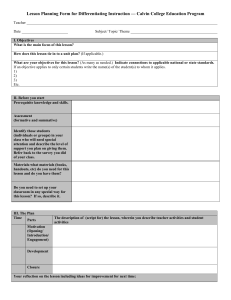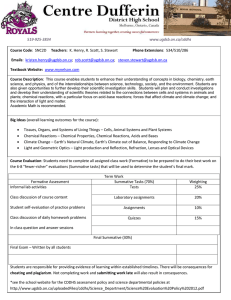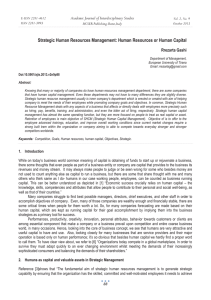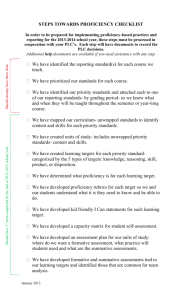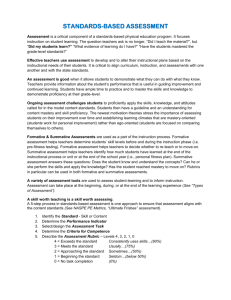Document 11973662
advertisement
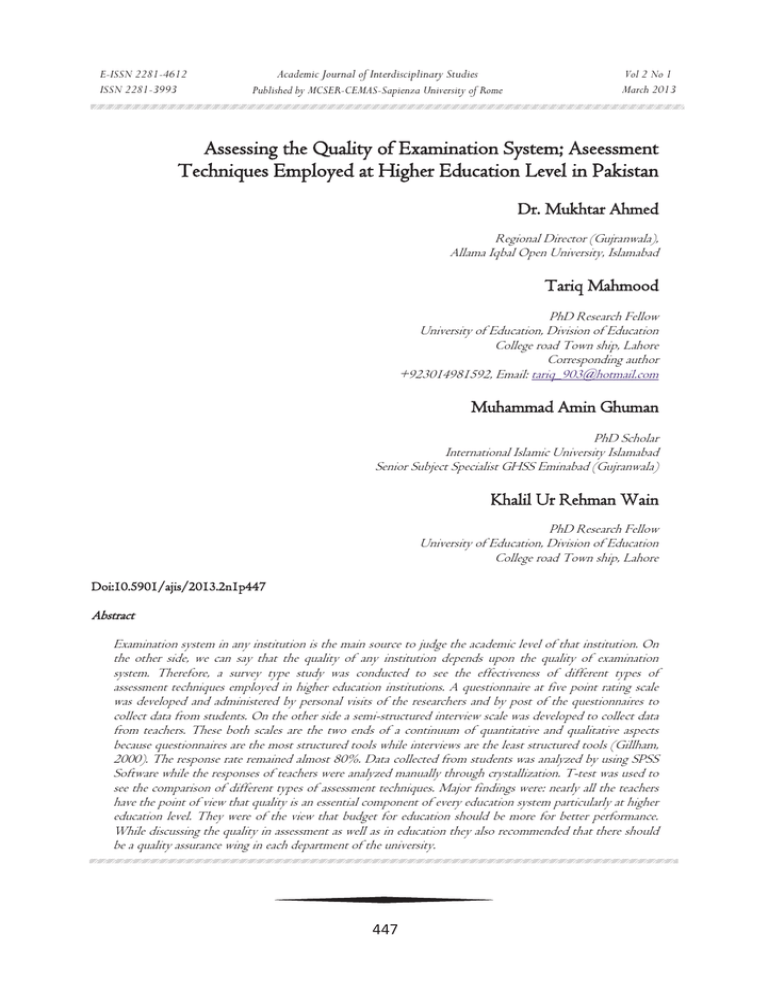
E-ISSN 2281-4612 ISSN 2281-3993 Academic Journal of Interdisciplinary Studies Published by MCSER-CEMAS-Sapienza University of Rome Vol 2 No 1 March 2013 Assessing the Quality of Examination System; Aseessment Techniques Employed at Higher Education Level in Pakistan Dr. Mukhtar Ahmed Regional Director (Gujranwala), Allama Iqbal Open University, Islamabad Tariq Mahmood PhD Research Fellow University of Education, Division of Education College road Town ship, Lahore Corresponding author +923014981592, Email: tariq_903@hotmail.com Muhammad Amin Ghuman PhD Scholar International Islamic University Islamabad Senior Subject Specialist GHSS Eminabad (Gujranwala) Khalil Ur Rehman Wain PhD Research Fellow University of Education, Division of Education College road Town ship, Lahore Doi:10.5901/ajis/2013.2n1p447 Abstract Examination system in any institution is the main source to judge the academic level of that institution. On the other side, we can say that the quality of any institution depends upon the quality of examination system. Therefore, a survey type study was conducted to see the effectiveness of different types of assessment techniques employed in higher education institutions. A questionnaire at five point rating scale was developed and administered by personal visits of the researchers and by post of the questionnaires to collect data from students. On the other side a semi-structured interview scale was developed to collect data from teachers. These both scales are the two ends of a continuum of quantitative and qualitative aspects because questionnaires are the most structured tools while interviews are the least structured tools (Gillham, 2000). The response rate remained almost 80%. Data collected from students was analyzed by using SPSS Software while the responses of teachers were analyzed manually through crystallization. T-test was used to see the comparison of different types of assessment techniques. Major findings were: nearly all the teachers have the point of view that quality is an essential component of every education system particularly at higher education level. They were of the view that budget for education should be more for better performance. While discussing the quality in assessment as well as in education they also recommended that there should be a quality assurance wing in each department of the university. 447 E-ISSN 2281-4612 ISSN 2281-3993 Academic Journal of Interdisciplinary Studies Published by MCSER-CEMAS-Sapienza University of Rome Vol 2 No 1 March 2013 1. Introduction 1.1 Background of Higher Education in Pakistan Higher Education is the infrastructure for future prosperity. The greatest treasure and asset of a nation are its educational institutions, because they build future nation. The purposes of higher education are multi-dimensional and may be termed as personal, social, economic and cultural. In the context of Pakistan, it has ideological meanings attached to its purposes as well. Religious, moral, historical and cultural ethos permeates through the fabric of the educational system of a country particularly higher education. The purpose of higher education is also to meet the socio-cultural and educational needs of the country. Higher education provides an opportunity of empowerment to an individual. It is responsible for high-level manpower needs of the country. The objectives of higher education are thus closely related to the needs of the society. (Isani & Virk, 2005). Assessment is necessary for all institutions, programs and projects for success and improvement. Different terms are used for the assessment processes i.e. measurement, test, assessment and evaluation. Measurement means assigning marks to students. Test is a set of questions used for the assessment of students. Assessment is a comprehensive term for the judgment of student’s performance but mostly covers quantitative position. Evaluation means the overall complete judgment of student’s performance. It covers both the quantitative as well as qualitative position (Linn & Gronlund, 2000). Faculty or teachers can assess student’s achievements and skills by using different methods. Multiple assessment methods and multiple raters ensure a variety of perspectives about the student’s performance that are included in the final evaluation of competence; thus decisions regarding promotion and graduation can be made with certainty. Because multiple directions of assessments help to investigate the quantitative as well as qualitative aspects of students’ performance. Assessment plays an important part in the teaching-learning process at all levels of education. Since assessment plays a significant role in upholding students’ future, there is no doubt that any assessment system will determine what students learn and the way in which they do this. Assessment also determines the way in which we teach and what we teach. Assessment is not just about grading and examinations; it is also about getting to know our students and the quality of their learning and to use this knowledge and understanding to their benefit. It is one of the major 'drivers' of the teachinglearning process. It is thus important for teaching staff to be familiar not only with the technical aspects of the many different forms of assessment currently in use but also with their advantages and limitations and about assessment issues and concerns. (http://www.city.londonmet.ac.uk). Pakistan’s Education Policy (2009) states that improving quality requires actions in the areas of teacher quality, curriculum and pedagogy, textbooks, assessment approaches, in learning environment and facilities. Assessment systems are quality measures that cater to a number of requirements of the education system. These can be used to measure overall system efficiency as well as individual student’s performance for movement in the education system. A comprehensive assessment design would provide feedback for improvements at all tiers starting from changes in the classroom to improvements in the national systems. Classroom Assessment is a simple method faculty can use to collect feedback, early and often, on how well their students are learning what they are being taught. Teachers also use informal observations to assess students’ perception. Teachers depend heavily on their impressions of student learning and make important judgments (Angelo & Cross, 1993). The mental transformation that we call learning on the part of the student could be facilitated by a combination of the following means on the part of the teacher who has the freedom to choose what he regards as the best curriculum design: appropriate objectives, syllabuses, reading lists, and modes of assessment. The true curriculum design includes 448 E-ISSN 2281-4612 ISSN 2281-3993 Academic Journal of Interdisciplinary Studies Published by MCSER-CEMAS-Sapienza University of Rome Vol 2 No 1 March 2013 preparation of teaching materials, classroom activities in lectures and tutorials, design of exercises, assignments, projects, and quizzes, feedback to students, and final examinations. Assessment is a systematic process that plays a significant role in effective teaching. It begins with the identification of learning goals and ends with a judgment concerning how well those goals have been attained. Student’s assessment and evaluation is central to every classroom at school, college and university level. It is how teachers find out what students are learning, how they are progressing, and how teachers can make improvements for their future development Many people think of evaluation as taking a snapshot of outcomes at the end of a program to confirm to a feedback about the effectiveness of the program. Some people don’t hold evaluation in much regard; they believe they are getting too little information too late in the day, especially if their program fell short of expectations or made no difference at all. However, evaluation can, and should, be used as an ongoing management and learning tool to progress an organization’s efficiency. Evaluation refers to a periodic process of gathering data and then analyzing it in such a way that the resulting information can be used to determine whether your organization or program is effectively carrying out planned activities. An evaluation can also illustrate the extent to which your organization or program is achieving its stated objectives and anticipated results. Basically there are four types of assessment techniques according to there consequences i.e. placement, formative, diagnostic and summative (Linn & Gronlund, 2000). Placement assessments are conducted at the start of any program or project. Formative and diagnostic assessments are same according to time but there is difference for there interpretation because diagnostic assessments are used to dig out some specific deficiencies or efficiencies of the particular individual. Diagnostic testing is the most important according to the learning point of view. Diagnostic testing is to identify the strengths and weaknesses of pupil learning and to pin point specific problems as precisely as possible (Stones, 1994). As formative assessments are used to know the results of continuous achievement levels of students so assigning marks are more suitable to develop competition among students. Smith & Gorard (2005) reported that when some teachers put comments but no marks on student’s work (a key feature of formative assessments), these students made less progress than others given marks. Summative assessments are used to see the overall performance of students at the end of the semester or year or program. Summative assessments will be more effective if they were developed and conducted by some external body with uniformity among the all the province or country students. For this purpose standardized test are most suitable to have equal view about all students. But the information or test will be gathered by some external body there will be pressure on teachers and ultimately teachers will guide there students how to get only good marks even through cramming which is wrong activity in teaching learning process (Harlen & Deakin Crick, 2003). Managers can and should conduct internal evaluations to get information about their programs so that they can make sound decisions about the execution of those programs. Internal evaluations should be conducted on an ongoing basis and applied carefully by managers at every level of an organization in all program areas. In addition, all of the program's participants (managers, staff, and beneficiaries) should be involved in the evaluation process in appropriate ways. This cooperation helps guarantee that the assessment is fully participatory and builds commitment on the part of all involved to use the results to make critical program improvements. Wiggins (1998) has used the term 'educative assessment' to describe techniques and issues that educators should consider when they design and use assessments. His message is that the nature of assessment influences what is learned and the degree of meaningful engagement by students in the learning process. While Wiggins contends that assessments should be authentic, with feedback and opportunities for revision to improve rather than simply audit learning, the more general principle is understanding how different assessments affect students. Will students be more engaged if assessment 449 E-ISSN 2281-4612 ISSN 2281-3993 Academic Journal of Interdisciplinary Studies Published by MCSER-CEMAS-Sapienza University of Rome Vol 2 No 1 March 2013 tasks are problem-based? How do students study when they know the test consists of multiple-choice items? What is the nature of feedback, and when is it given to students? How does assessment affect student effort? Answers to such questions help teachers and administrators understand that assessment has powerful effects on motivation and learning. Just as assessment impacts student learning and motivation, it also influences the nature of instruction in the classroom. There has been considerable recent literature that has promoted assessment as something that is integrated with instruction, and not an activity that merely audits learning (Shepard, 2000). When assessment is incorporated with instruction it informs teachers about what activities and assignments will be most useful, what level of teaching is most suitable, and how summative assessments can also provide diagnostic information. For instance, during instructional activities, informally, formative assessment helps teachers know when to move on, when to ask more questions, when to give more examples, and what responses to student questions are most appropriate. Standardized test scores, when used appropriately, help teachers understand student strengths and weaknesses to target further instruction. There are three distinct but inter-related purposes for classroom assessment: assessment for learning, assessment as learning, and assessment of learning. 1. Assessment for learning is designed to give teachers information to modify and differentiate teaching and learning activities. 2. Assessment as learning is a process of developing and supporting metacognition for students. Assessment as learning focuses on the role of the student as the critical connector between assessment and learning. 3. Assessment of learning is summative in nature and is used to confirm what students know and can do, to demonstrate whether they have achieved the curriculum outcomes, and, occasionally, to show how they are placed in relation to others. Assessment for learning, assessment as learning, and assessment of learning all serve valuable, and different, purposes. It is not always easy, however, getting the balance right. If we want to enhance learning for all students, the role of assessment for learning and assessment as learning takes on a much higher profile than assessment of learning. Traditionally, the focus of classroom assessment has been on assessment of learning—measuring learning after the fact, using the information to make judgments about students’ performances, and reporting these judgments to others. Teachers traditionally have also been using assessment for learning when they built in diagnostic processes, formative assessment, and feedback at various stages in the teaching and learning process, though it was often informal and implicit. Systematic assessment as learning—where students become critical analysts of their own learning—was rare. Although some teachers have incorporated selfassessment into their programs, few have systematically or explicitly used assessment to develop students’ capacity to evaluate and adapt their own learning. (Western and Northern Canadian Protocol, 2006) Researchers, policymakers, parents, and even teachers themselves agree that education level in its qualitative aspect is deteriorating in Pakistan. Assessment is a basic tool and way to diagnose the efficiency and effectiveness of any program. In Pakistan up to intermediate level the autonomous bodies which assess and assign certificates are Boards of Intermediate and Secondary Education, while from bachelors and upward levels/degrees universities are the autonomous and authoritative institutions to assess and award degrees. Assessment system in Pakistan is focused on assessing the memorization or retention level of students even at masters level which is alarming situation in our education institutions. Tests are used as the basic and major assessment tools to diagnose the learning level of students. Due to these and other reasons it was observed that a study to see the qualitative aspects of assessment tools used in Pakistan is highly necessary. 450 E-ISSN 2281-4612 ISSN 2281-3993 Vol 2 No 1 March 2013 Academic Journal of Interdisciplinary Studies Published by MCSER-CEMAS-Sapienza University of Rome 2. Methodology of the Study Survey type study was conducted to see the effectiveness of different types of assessment techniques employed in higher education institutions. A questionnaire at five point rating scale was developed and administered by personal visits of the researchers and by post of the questionnaires to collect data from students. At the end of this scale two open ended questions were also added two ask about what is quality and to get suggestion for improvement. On the other side a semi-structured interview scale was developed to collect data from teachers. Five point rating scale was developed to see the convergent point of view of students, while interview schedule was developed to know the divergent views of teachers. These both scales are the two ends of a continuum of quantitative and qualitative aspects because questionnaires are the most structured tools while interviews are the least structured tools (Gillham, 2000). The response rate remained almost 80%. Data collected from students was analyzed by using SPSS Software while the responses of teachers were analyzed manually through crystallization. As a whole the collected data was analyzed by using both descriptive as well as inferential statistics. Ttest was used to see the comparison of different types of assessment techniques and them again the percentage answers of the respondents about different types of assessment techniques was used to see the extent of use these techniques at higher education level. Results of t-test are shown only in tables while the results of percentages are shown both in table and graph. As data was collected through interview schedule from teacher so their responses were crystallized and it was found that nearly all the teachers have the point of view that quality is an essential component of every education system particularly at higher education level. In detail they said that quality in assessment techniques means the quality in whole teaching learning process. But this point of view is against the Edward demings sixteen quality indicators. He says “reduce the need of testing”. When teachers were explaining that quality is necessary, in the mean while they were also saying that we are not providing with such equipment so that we cannot produce quality in education. They were of the view that budget for education should be more for better performance. While discussing the quality in assessment as well as in education they also recommended that there should be a quality assurance wing in each department of the university. In Pakistan HEC is also taking some initiative steps in developing quality in different aspects of university education. 3. Discussion and Interpretation of Results Table # 1: Results of T-test of assessment techniques Assessment Technique Mean Objective type questions 3.8049 Essay type questions 3.9164 St. Deviation Sig. Value t-value 1.49642 .208 -1.262 Results of t-test show that according student’s point of view multiple choice questions (MCQs) as well as essay type questions are of equal level to assess the learning achievement of students at higher education level. On the other side teacher’s point of view is different from student’s counterpart. Teachers are of the view that MCQs are not up to the mark in assessing proper higher order learning of students because the very basic purpose of MCQs is uniformity and objectivity in scoring (Anastasi & Urbina, 1997). But according to teacher’s point of view essay type questions are more appropriate in assessing the learning achievement as well as higher order thinking of students. Kobiszyn & Borich (2004) also narrates essay type questions are most effective technique in assessing the complex learning 451 E-ISSN 2281-4612 ISSN 2281-3993 Vol 2 No 1 March 2013 Academic Journal of Interdisciplinary Studies Published by MCSER-CEMAS-Sapienza University of Rome outcomes. Student’s responses are also shown in tables as well in graphs. Graph # 1 shows that 70% students are in favor of objective type questions while 76% are in the favor of essay type questions. Graph # I: Comparison of Objective type and Essay type Questions Table # 2: Results of T-test of assessment techniques Assessment Technique Mean Assignments 4.1463 Research projects 3.7979 St. Deviation Sig. Value t-value 1.36022 .000 -4.340 According to new theories which base on students centered education system; focus on the self work done by the student. At higher education level normally research becomes the more important than theory. Assignments and research projects are research oriented activities. Students responses show that assignment are more important and effective in assessing the student’s learning achievement level because in assignments there are two aspects, one preparation, and second is presentation of that assignment. Teachers also have the same view with slight difference that research projects are more important for M. Phil and Ph. D programs while assignment are more feasible for Masters level programs. Graph # II also show that almost 10% more students are in the favor of assignment as a good assessment tool than research project. This difference between student’s and teacher’s responses may be due to the majority of maters level students rather than that of M. Phil or Ph. D programs. 452 E-ISSN 2281-4612 ISSN 2281-3993 Vol 2 No 1 March 2013 Academic Journal of Interdisciplinary Studies Published by MCSER-CEMAS-Sapienza University of Rome Graph # II: Comparison of Assignment and Research Project Table # 3: Results of T-test of assessment techniques Assessment Technique Mean Presentations 4.5192 Class/group discussions 4.2334 St. Deviation Sig. Value t-value .90177 .000 5.368 An other interesting and practice oriented work at higher education level is participation in the classroom setting. Presentation in front of class fellows or discussion in the classroom is also participative activity. Students have the view that presentation is more effective tool than group discussion. In presentation student has to build his confidence once at the start of presentation then the presenter becomes dominant in the classroom. But in group discussion all the students have equal chance to participate and share ideas. Here in this regard teachers also have the same view that presentation is more effective technique because it provides multi directional aspects of students. Graph III also show that 92% students are in favor of presentation while 83% students think that group discussion is more appropriate. 453 E-ISSN 2281-4612 ISSN 2281-3993 Vol 2 No 1 March 2013 Academic Journal of Interdisciplinary Studies Published by MCSER-CEMAS-Sapienza University of Rome Graph # III: Comparison of Presentation and Group discussion Table # 4: Results of T-test of assessment techniques Assessment Technique Mean Group projects 4.2160 Quiz programs 4.1707 St. Deviation Sig. Value t-value .96152 .425 .798 Group projects and quiz programs are also important for brain storming which is an essential component of critical thinking development. Mean values as well as percentages shown in the graph # IV depict that students are highly interested to participate and assessed through group projects because they are completely related to self work. Students are in favor of group project and quiz programs 84.8% and 85.7% respectively. This aspect was not put inform of teachers to get their views. Graph # IV: Comparison of Group projects and Quiz programs 454 E-ISSN 2281-4612 ISSN 2281-3993 Vol 2 No 1 March 2013 Academic Journal of Interdisciplinary Studies Published by MCSER-CEMAS-Sapienza University of Rome Table # 5: Results of T-test of assessment techniques Assessment Technique Continuous assessment Summative assessment Mean 4.3728 3.9930 St. Deviation Sig. Value t-value 1.24822 .000 5.155 There are basically to forms of assessment i.e. during the program and at the end of the program. As universities are autonomous bodies and follow the internal assessment system. Universities conduct tests during the program as well as at the end of the semester which are called formative and summative tests respectively. When students were asked about these two types of assessment students were more in favor of only continuous (formative) rather than summative. Graph # V also shows that 89.2% students were in favor of continuous assessment system while 77.7% students were in favor of summative system. On the other side teachers were also in favor of formative and diagnostic assessment system as well as summative assessment system. But the difference is only that teachers say that 70% focus should be on formative and diagnostic assessment and only 30% focus should be on summative exam. Graph # V: Comparison of Continuous assessment and Summative assessment Table # 6: Results of T-test of assessment techniques Assessment Technique Continuous assessment Mean 4.3728 St. Deviation Sig. Value t-value Comprehensive exam 2.9965 1.55703 .000 14.975 Almost all universities have internal as well as a little bit external assessment system. Summative test is a part of internal assessment system while comprehensive exam is totally external in some universities of Pakistan while in some universities it is partially external. Either it is totally external or partially external students greatly reject this system of examination. T-test shows that there is significant difference in the views of students about the use of comprehensive exam. This view looks appropriate because I personally know that students who have passed with “A” grade in continuous assessment failed 455 E-ISSN 2281-4612 ISSN 2281-3993 Academic Journal of Interdisciplinary Studies Published by MCSER-CEMAS-Sapienza University of Rome Vol 2 No 1 March 2013 in comprehensive exam. Graph # VI that 89.2% students are in favor of continuous assessment system and only 41.8% students responded in favor of comprehensive exam. Teachers were more rigorous in rejecting comprehensive exam particularly those university’s teachers which have totally external system in comprehensive exam. They say that this comprehensive exam means teacher’s assessment process is not reliable. Graph # VI: Comparison of Continuous assessment and Summative assessment Open ended questions which were added at the end were analyzed manually and shocking results found. Almost all the students do not know about what is quality in assessment system. While in the second question about suggestion a few students responded. The focus of these suggestions was there should be fair and objective marking. Also some students suggested that continuous assessment should be in a very stream line with proper feedback. Teachers were also emphasized that at higher education level formally assignments and tests are the basic assessment tools to measure student’s performance level. 4. Major Findings ¾ ¾ ¾ ¾ ¾ Teachers are greatly in favor to focus on qualitative aspects of education but they are not provided with required sufficient resources. Almost all the teachers are in the favor to establish a fair working quality assurance wing in all the departments in universities. One contrasting thing is that majority of the students are in favor of MCQs in examination but teachers were favor of essay type questions because they are related to qualitative aspects. Majority of the students greatly reject comprehensive exam or UQE which is conducted at the end of the program. Above discussion show that majority of the students are interested in activities that are related to self work. 5. Recommendations 9 Teachers should be fair in their marking without any subjectivity. 456 E-ISSN 2281-4612 ISSN 2281-3993 9 9 9 9 Academic Journal of Interdisciplinary Studies Published by MCSER-CEMAS-Sapienza University of Rome Vol 2 No 1 March 2013 Proper feedback to students in continuous assessment system enhances student’s comprehension and learning level. More focus should be on self work or practical instead of theory. Comprehensive exam or university qualifying examination (UQE) should be redesigned or finished. It is strongly recommended that studies on every assessment tool (assignment, test, project etc.) should be conducted separately to investigate in more depth. References Anastasi, A. & Urbina, S. (1997). Psychological Testing. 7th (Ed.) Delhi: Pearson, Prentice Hall. Angelo, T.A., & Cross, K.P. (1993). Classroom Assessment Techniques: A Handbook for College Teachers. San Francisco: Jossey-Bass. Gillham, B. (2000). Developing a Questionnaire. New York: Continuum. Government of Pakistan, Ministry of Education, National Education Policy, 2009, Islamabad. Harlen, W., & Deakin Crick, R. (2003). Testing and Motivation for Learning. Assessment in Education. 10 (2). http://www.city.londonmet.ac.uk Isani, C.U.A.G. & Virk, M. L. (2005). Higher Education in Pakistan. Islamabad: National Book Foundation. Kubiszyn, T. & Borich, G. (2004). Educational Testing and Measurement: Classroom Application and Practice. New York: John Wiley & Sons. Inc. Linn, R. L. and Gronlund, N. E. (2000). Measurement and Assessment in Teaching. 8th (Ed.) Delhi: Pearson Education. Memon, G. R. (2007). Education in Pakistan: The Key Issues, Problems and The New Challenges. Journal of Management and Social Sciences. Vol. 3, No. 1 pp. 47-55. Shepard, L. A. (2000). The role of assessment in a learning culture. Paper presented at the Annual Meeting of the American Educational Research Association. Access at 20-04-2007 from: http://ericae.net/scripts/ft/ftget.asp?want=http://www.aera.net/meeting/am2000/wrap/praddr01. htm Smith, E., & Gorard, S. (2005). “They Don’t give us our marks” The role of formative feedback in Student progress. Assessment in Education. 29 (1). Stones, E. (1994). Quality Teaching: A Sample of Cases. New York: Routledge. Western and Northern Canadian Protocol, (2006). Available at www.wncp.ca Wiggins, G. (1998). Educative assessment: Designing assessments to inform and improve student performance. San Francisco: Jossey-Bass. 457
